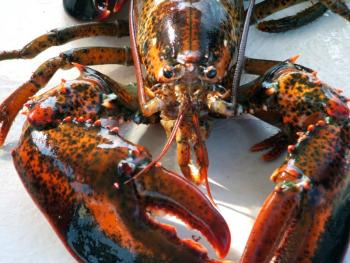Maine Department of Marine Resources receives funding to improve lobster research
The Maine Department of Marine Resources has received approximately $100,000 from the 2020 National Sea Grant American Lobster Initiative to improve research into a key indicator of the lobster population's health, and to develop a publicly available database of information for use by researchers.
The work will include an examination of a potentially less costly and more efficient method to examine the size at which female lobsters mature.
Research that studies the size of female lobsters at the point when they become capable of egg production is used in the Atlantic States Marine Fisheries Commission American Lobster Stock Assessment to predict the growth of female lobsters and to estimate egg production in the stock.
To-date, the method for studying the size at maturity has required large sample sizes and lab work that involves over a dozen measurements for each lobster related to growth and reproductive development. This method of testing is both time consuming and costly. The cost to conduct this lab testing at DMR over the last three years has been approximately $100,000.
Because of the cost to conduct maturity work in the lab, there had been no new data from the mid-1990s until the last three years when funding became available through the Maine Lobster Research, Education, and Development Fund. "The datasets from 25 years ago are no longer an accurate reflection of female reproductive development," said Jes Waller, a DMR scientist leading the work.
The department will use these Sea Grant funds to examine a method that uses blood drawn from lobsters caught by DMRs sea sampling program, to examine protein levels that indicate reproductive development. DMR will collaborate with researchers and students at Dalhousie University to complete this work. The department will be able to conduct the new analysis for two years at a cost of $25,000 because testing is done on thousands of samples collected and stored by DMR as a result of previous research. The cost and effort needed will drop considerably in the coming years as this new method is developed and the number of required samples declines.
DMR will also use the funds to establish an online library of images of pleopod samples along with data associated with each sample. Pleopods hold eggs under the lobsters tail and provide insights into a females molting schedule and reproductive development. The online database will provide resources for researchers at DMR and elsewhere.
DMR will collaborate in other National Sea Grant funded studies. DMR will lead most of the field sampling for a study conducted by the Atlantic Offshore Lobstermens Association in collaboration with Hood College, New Hampshire Fish & Game, and Maine Maritime Academy that will examine the distribution and abundance of lobster larvae and their potential food sources in nearshore and offshore areas of the GOM.
Additionally, DMR is contributing to a funded project with University of Maine, Maine Center for Coastal Fisheries, National Marine Fisheries Service, and the Maine Lobstermen' s Association evaluating socio-economic indicators of resilience in the lobster fishery.
DMR will also support a University of Maine collaboration with the Atlantic States Marine Fisheries Commission that seeks to improve the stock assessment for lobster, and another with the Gulf of Maine Research Institute that assesses the influence of environmental variables and species-to-species interactions on lobster distribution and abundance.
"Maine DMR has committed to expanding lobster research capacity and these National Sea Grant projects are an exciting next step," said DMR Commissioner Patrick Keliher.
More information on each funded project can be found at https://seagrant.noaa.gov/News/Article/ArtMID/1660/ArticleID/2809/Sea-Grant-announces-2-million-in-support-of-2020-American-Lobster-Initiative-projects
Event Date
Address
United States





































